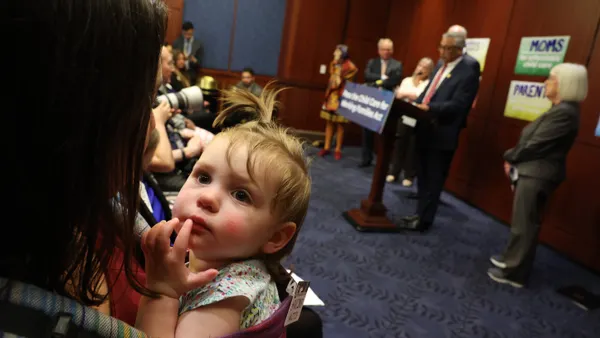Dive Brief:
- Northeast Business Group on Health (NEBGH) and AARP released a new tech-based guide to help benefits experts and HR leaders support a growing number of employee caregivers. According to AARP, 24 million caregiver families are balancing work and home responsibilities.
- The guide presents lists of available tools, including digital platforms for connecting caregivers to other caregivers and to people with similar diagnoses; monitoring tools for in-home patients; and health management tools. The guide also shows employers how to develop a digital-tools program and includes sections on common caregiver challenges and advice on assessing the value added to organizations offering digital platforms.
- The guide also helps employers evaluate the various types of digital features with the greatest benefit for employee caregivers, lists the latest tools and capabilities and features a checklist for identifying the best tools and services. It also identifies some challenges and solutions surrounding digital caregiving tools. When an employer invests in a digital tool, for example, they need to match that investment with targeted marketing and communications within the organization so the right employees can access it.
Dive Insight:
Just about every workforce has employees who are trying to manage work and fulfill caregiving responsibilities, experiencing burnout as a result and facing financial hurdles associated with the medical costs. Employees might be the caretakers of newborns, aging parents or both aging parents and children simultaneously, as well as family members with drug addictions who need care. A survey released in June found that 60% of working parents suffered from burnout. For 29% of respondents, said burnout was due to exhaustion from jobs inside and outside the home. According to a 2017 poll, caregivers spend $190 billion a year on healthcare and support services for loved ones. Research makes clear that the burden of caretaking can be weighty.
Digital-tool guides like NEBGH and AARP's offer innovative options for caregivers to support their loved ones and employers to keep caregivers engaged and onboard. Employers also can offer paid family leave — the most valued benefit cited by workers in certain polls. Paid family leave addresses both the demands on caregivers' time, as well as their need for an uninterrupted income. Still, caregiver paid time off (PTO) remains a costly benefit for some employers, especially small businesses.
Flexible work schedules are a top priority among employees with caregiving responsibilities, according to a study released in June by Unum. Almost 90% of workers surveyed said an employer's leave policies are major factors in their decision to stay on or leave a job. Compared to PTO, flexible work schedules could be a less costly benefit for small companies to offer caregivers.










